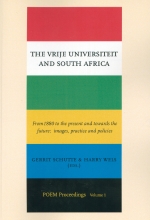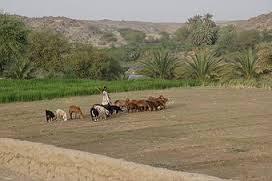POEM: Some Trends In South African Academic History: Changing Contexts And Challenges
 Seismographic social and political shifts introduced the 1990s: the end of the Cold War, the demise of communism abroad, and in South Africa the official end of apartheid and the subsequent instalment of a new democratic government. Given these developments it is reasonable to expect that historians, who construct their versions of the past in the present, and are at least to some degree influenced by that present, should, in the light of wider contextual changes, re-evaluate their approaches and revise their interpretations. The relationship between societal change and historical production is, however, not a simple one-to-one function.
Seismographic social and political shifts introduced the 1990s: the end of the Cold War, the demise of communism abroad, and in South Africa the official end of apartheid and the subsequent instalment of a new democratic government. Given these developments it is reasonable to expect that historians, who construct their versions of the past in the present, and are at least to some degree influenced by that present, should, in the light of wider contextual changes, re-evaluate their approaches and revise their interpretations. The relationship between societal change and historical production is, however, not a simple one-to-one function.
It is against this background that this paper seeks to identify and briefly explore selective developments pertaining to the dynamics of the historical profession in South Africa and the intellectual correlates that help to define the current nature of the enterprise. The paper focuses only on certain aspects and makes no claim to have covered the vast and treacherous area exhaustively.
Academic historians and the question of growth
The 1990s were not the most auspicious of times for the profession. Instead of bewailing this fact, it may be more profitable to apply historical insights to the phenomenon and to ask what are the conditions that are particularly conducive for the expansion of the historical enterprise as practiced professionally? This necessitates a brief look at the contextual forces that helped to shape the profession in South Africa. Read more
Governance and Development in Southern Africa – Development Policy Review Network
On 13 November 2007, some thirty Dutch and South African practitioners, policy makers and academics, all working on the subject of governance and development in southern Africa, came together for a day of discussions. Although all grappling with similar subjects in their respective professional lives, these three groups of professionals seldom meet each other in forums that are explicitly designed to foster debates and cooperation across the professional boundary lines.
The Proceedings from the Third DPRN regional expert meeting on Southern Africa (2007 – published 2010) .
2. Henk Molenaar and Marjoke Oosterom – Negotiating knowledges for development
3. Anshu Padayachee and Ashwin Desai – Post-apartheid South Africa and the crisis of expectation
Public-Private Partnerships in Rural Development, Downplaying the Role of Politics and Power Relations – DPRN Two
Introduction
Public Private Partnerships, or PPPs, are increasingly popular in the field of international development cooperation and sustainable development. Though PPPs are not a new phenomenon (see Linder 1999), their popularity in policy circles has steadily augmented since the late 1980s (Entwistle and Martin 2005) to a point where their promotion seems to have become a dominant ‘development narrative’ (cf. Roe 1991; 1995). PPPs are promoted as the most logical solution to a variety of service delivery and development problems, and are often presented as ‘technical’, politically neutral solutions (cf. Ferguson 1990). Nevertheless, the promotion and development of PPPs has a distinct ideological background and flavour (Linder 1999; Entwistle and Martin 2005). PPP’s present popularity followed after their (re-)introduction in the wake of the wave of privatisation of government institutions by conservative governments in Europe and the US – notably the Reagan administration and Thatcher’s government – in the 1980s. The idea of the need for the privatisation of government services was exported to developing countries through the many Structural Adjustment Programmes enforced by the IMF and supported by the World Bank. PPPs were considered ‘softer’ versions of the same process (Entwistle and Martin 2005) that would have less dramatic social consequences and therefore would be more palatable to the general public. Subsequently, New Labour stressed the partnership idea in PPPs, and the influence it is supposed to accord not only to the corporate sector, but also to civil society organisations (ibid.). However, there is an ongoing debate about whether the growing influence of civil society organisations is a counterpoint to the neo-liberal approach, as Escobar (1995) argues, or whether this is part and parcel of a neo-liberal approach (see e.g. Levine 2002). Read more
Negotiating Knowledges for Development – DPRN Three
A Tribute to Saartjie Baartman
I’ve come to take you home –
home, remember the veld?
the lush green grass beneath the big oaks trees
the air is cool there and the sun does not burn.
I have made your bed at the foot of the hill,
your blankets are covered in buchu and mint,
the proteas stand in yellow and white
and the water in the stream chuckle sing-songs
as it hobbles alone over little stones.
I have come to wretch you away –
away from the poking eyes
of the man-made monster
who lives in the dark
with his clutches of imperialism
who dissects your body bit by bit
who likens your soul to that of Satan
and declares himself the ultimate god!
I have come to soothe your heavy heart
I offer my bosom to your weary soul
I will cover your face with the palms of my hands
I will run my lips over lines in your neck
I will feast my eyes on the beauty of you
and I will sing for you
for I have come to bring you peace.
I have come to take you home
where the ancient mountains shout your name.
I have made your bed at the foot of the hill,
your blankets are covered in buchu and mint,
the proteas stand in yellow and white –
I have come to take you home
where I will sing for you
for you have brought me peace
Diana Ferrus
Saartjie Baartman
This poem, written by the South African Diana Ferrus, refers to the return of Saartjie Baartman to her home country. On Women’s Day, 9 August 2002, the remains of Saartjie Baartman were finally laid to rest in the area of her birth, the Gamtoos River Valley in the Eastern Cape. Thus ended a long period of exile in life and in death of a young Khoikhoi woman, who was to become an icon in South Africa as a victim of the horrors of colonialism and racism.
Born in 1789 and orphaned in a commando raid, Saartjie Baartman became the servant of the Dutch farmer Johan Cezar near Cape Town. When his brother Henrik Cezar and his friend, the ship’s doctor William Dunlop, visited Johan in 1810, they met with Baartman and convinced her that it would be to her advantage to accompany them to Europe. Each for his own reasons wanted to make the most out of her physical characteristics. From the 17th century onward, Europeans had been fascinated by the steatopygia, the broad hips and large buttocks, of Khoikhoi women. Furthermore, Khoikhoi women knew the custom of elongating the labia to conform to an ideal of beauty. The resulting sinus pudoris, or ‘curtain of shame’ equally was a source of fascination frequently mentioned in both popular and scientific literature. Read more
Nelson Mandela 1918 – 2013
Nelson Mandela’s Inaugural Address – May, 10, 1994
See: http://www.nelsonmandela.org/
Land And Agrarian Reform In South Africa: Caught By Continuities – DPRN Six
Introduction
Land and agrarian reform is often implemented with a view to breaking with the past, particularly by transforming ownership of land and its uneven distribution. The post 1994 land and agrarian reform in South Africa began with a similar agenda. In fact land reform was launched and implemented even before Apartheid was dissolved and the new ANC-led government took control. The Apartheid government under F.W. De Klerk initiated some kind of limited land reform during the period from 1990 to 1993.
In March 1991, De Klerk’s government repealed the 1913 and 1936 Land Acts. In November of the same year it appointed an Advisory Committee on Land Allocation (later renamed as the Commission on Land Allocation). The Commission made recommendations on state land disposal and the restoration of land to those disposed of formal land rights. This happened first in Natal, where dispossessed communities in Richards Bay (van Leynseele and Hebinck, 2008), Roosboom, Charlestown and Alcockspruit got their land rights formally restored in the years 1992-93 through this process (Walker 2004). The strengths and weaknesses of the pre-1994 land reforms were replicated post-1994 in the form of a lack of ‘coherent state procedures and institutional inadequacies’ to manage the land reform process (Walker 2004; 2005).
This paper explores the institutional dynamics by pursuing the argument that contemporary land reform policy and practices are characterised by continuities, rather than by discontinuities. Given the radical policy discourse of Reconstruction and Development, political and economic transformation, one may expect more discontinuities to occur than continuities. The shift from the early emphasis on human rights to paternalism and ‘productionism’ (from LRAD to SLAG) is testimony of what we would brand as continuities. The assumption of our investigation is that during Apartheid land use on white-owned farms was production and market oriented. Discontinuities no doubt occur; towards the end of the paper we will provide a few examples that show that land once designated for white ownership and ‘commercial agriculture’ is now being redeveloped into land owned by black people who by and large use the land – quoting an informant one of us spoke to in November 2007 in the Eastern Cape – ‘the African way’.[i]
The organising notion of continuity (and discontinuity) is useful for an analysis of changes over time. Continuity refers to the state of uninterrupted flow or coherence, or the property of a continuous and connected period of time (Oxford English Dictionary). Synonyms are persistence, enduringness, durability, lastingness, strength or permanence by virtue of the power to resist stress or force. The continuities that will be explored in this paper relate to the agricultural expert system that has gradually evolved in South Africa and which plays a prominent role in the design of land reform. The persistence of continuities would then indicate the extent to which dramatic transformations of the institutional infrastructure in agriculture have occurred. Historical analysis allows us to underline the continuity of prescriptions and modes of ordering in the past and present. Distinctions between the pre-apartheid, apartheid and post-apartheid periods belie the existence of important continuities.
The setting is the Eastern Cape Province, notably the regions formerly known as Ciskei and Transkei. The case material to underline the argument of continuity rather than discontinuity are entrenched in the prescriptive policies of the state with regard to land use as well as in the multiple responses of land users. Such policies are largely informed by agricultural expert opinions with regard to land use such that they have helped to create and order South Africa’s agrarian landscapes. The Glen Grey Act of 1894 evolved into Betterment Planning practices dictating and attempting to change land use patterns. Current land reform policies aim to prescribe similarly land use by paternalistically fixing land reform subsidies to forms of land use that fit into the category of ‘commercial agriculture’. Like James (2007), we intend to pursue the provoking argument that the current Department of Land Affairs (DLA) and National and Provincial Departments of Agriculture are rather similar to their Apartheid era predecessors, the Department of Native Affairs and the Native Agricultural and Lands Branch. Read more






